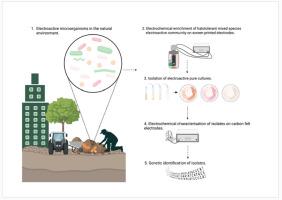当前位置:
X-MOL 学术
›
Electrochim. Acta
›
论文详情
Our official English website, www.x-mol.net, welcomes your
feedback! (Note: you will need to create a separate account there.)
Electrochemical enrichment of a community of weak electricigens and characterisation of three halotolerant electroactive isolates: Micrococcus sp. YH-1, Gordonia sp. RH-1 and Stutzerimonas sp. CH-1
Electrochimica Acta ( IF 5.5 ) Pub Date : 2024-11-12 , DOI: 10.1016/j.electacta.2024.145350 Debasa Mukherjee, Lucinda Elizabeth Doyle
Electrochimica Acta ( IF 5.5 ) Pub Date : 2024-11-12 , DOI: 10.1016/j.electacta.2024.145350 Debasa Mukherjee, Lucinda Elizabeth Doyle

|
Microbial electroactivity in elevated salt conditions is seldom studied, despite both fundamental and applied relevance. This work reports the enrichment of electroactive microorganisms under saline conditions (2 % NaCl), performed on screen-printed carbon electrodes with applied anodic potential. From the weakly electroactive enriched community, three halotolerant electroactive isolates were obtained in pure culture and identified via 16S rRNA gene sequencing. Two isolates were Gram positive (proposed names Micrococcus sp. YH-1 and Gordonia sp. RH-1) and one was Gram negative (proposed name Stutzerimonas sp. CH-1). The isolates were electrochemically characterised on conventional carbon felt electrodes using chronoamperometry. After two days of growth, a current density of 8.29 ± 0.85 μA/cm2 was observed in Micrococcus sp. YH-1, comparable to reported values for the model electroactive microorganism Shewanella oneidensis. Gordonia sp. RH-1 and Stutzerimonas sp. CH-1 appeared to be weak electricigens due to their low current output (2.19 ± 0.46 μA/cm2 and 1.73 ± 0.47 μA/cm2 , respectively). The isolates are notable as there are very limited reports of electroactivity in the genera Micrococcus and Gordonia . Cyclic voltammetry revealed prominent redox peaks in Micrococcus sp. YH-1 and Stutzerimonas sp. CH-1. Scanning electron microscopy demonstrated colonisation of the electrode by each isolate, along with thin cellular appendages in Micrococcus sp. YH-1 and Stutzerimonas sp. CH-1. This work extends the catalogue of characterised halotolerant electroactive microbes while also enhancing our understanding of weak electricigens, extracellular electron transfer in Gram positives, and the inherent electroactivity of the natural environment.
中文翻译:

弱电学群落的电化学富集和三种耐盐电活性分离株的表征:微球菌属 YH-1、戈登菌属 RH-1 和 Stutzerimonas 属 CH-1
尽管具有基本和应用相关性,但很少研究高盐条件下的微生物电活性。这项工作报告了在盐水条件 (2% NaCl) 下在施加阳极电位的丝网印刷碳电极上进行的电活性微生物的富集。从弱电活性富集群落中,在纯培养物中获得 3 种耐盐电活性分离株,并通过 16S rRNA 基因测序鉴定。两个分离株是革兰氏阳性菌(提议的名称是 Micrococcus sp. YH-1 和 Gordonia sp. RH-1),一个是革兰氏阴性菌(提议的名称是 Stutzerimonas sp. CH-1)。使用计时安培法在常规碳毡电极上对分离物进行电化学表征。生长两天后,在微球菌属 YH-1 中观察到 8.29 ± 0.85 μA/cm2 的电流密度,与模型电活性微生物 Shewanella oneidensis 的报告值相当。Gordonia sp. RH-1 和 Stutzerimonas sp. CH-1 由于电流输出低(分别为 2.19 ± 0.46 μA/cm2 和 1.73 ± 0.47 μA/cm2),因此似乎是弱电学。这些分离株值得注意,因为在 Micrococcus 和 Gordonia 属中关于电活性的报道非常有限。循环伏安法显示微球菌属 YH-1 和 Stutzerimonas 属 CH-1 中存在明显的氧化还原峰。扫描电子显微镜显示每个分离物在电极上定植,以及微球菌属 YH-1 和 Stutzerimonas sp. CH-1 中的薄细胞附属物。这项工作扩展了表征耐盐电活性微生物的目录,同时还增强了我们对弱电、革兰氏阳性细胞外电子转移以及自然环境固有电活性的理解。
更新日期:2024-11-12
中文翻译:

弱电学群落的电化学富集和三种耐盐电活性分离株的表征:微球菌属 YH-1、戈登菌属 RH-1 和 Stutzerimonas 属 CH-1
尽管具有基本和应用相关性,但很少研究高盐条件下的微生物电活性。这项工作报告了在盐水条件 (2% NaCl) 下在施加阳极电位的丝网印刷碳电极上进行的电活性微生物的富集。从弱电活性富集群落中,在纯培养物中获得 3 种耐盐电活性分离株,并通过 16S rRNA 基因测序鉴定。两个分离株是革兰氏阳性菌(提议的名称是 Micrococcus sp. YH-1 和 Gordonia sp. RH-1),一个是革兰氏阴性菌(提议的名称是 Stutzerimonas sp. CH-1)。使用计时安培法在常规碳毡电极上对分离物进行电化学表征。生长两天后,在微球菌属 YH-1 中观察到 8.29 ± 0.85 μA/cm2 的电流密度,与模型电活性微生物 Shewanella oneidensis 的报告值相当。Gordonia sp. RH-1 和 Stutzerimonas sp. CH-1 由于电流输出低(分别为 2.19 ± 0.46 μA/cm2 和 1.73 ± 0.47 μA/cm2),因此似乎是弱电学。这些分离株值得注意,因为在 Micrococcus 和 Gordonia 属中关于电活性的报道非常有限。循环伏安法显示微球菌属 YH-1 和 Stutzerimonas 属 CH-1 中存在明显的氧化还原峰。扫描电子显微镜显示每个分离物在电极上定植,以及微球菌属 YH-1 和 Stutzerimonas sp. CH-1 中的薄细胞附属物。这项工作扩展了表征耐盐电活性微生物的目录,同时还增强了我们对弱电、革兰氏阳性细胞外电子转移以及自然环境固有电活性的理解。































 京公网安备 11010802027423号
京公网安备 11010802027423号